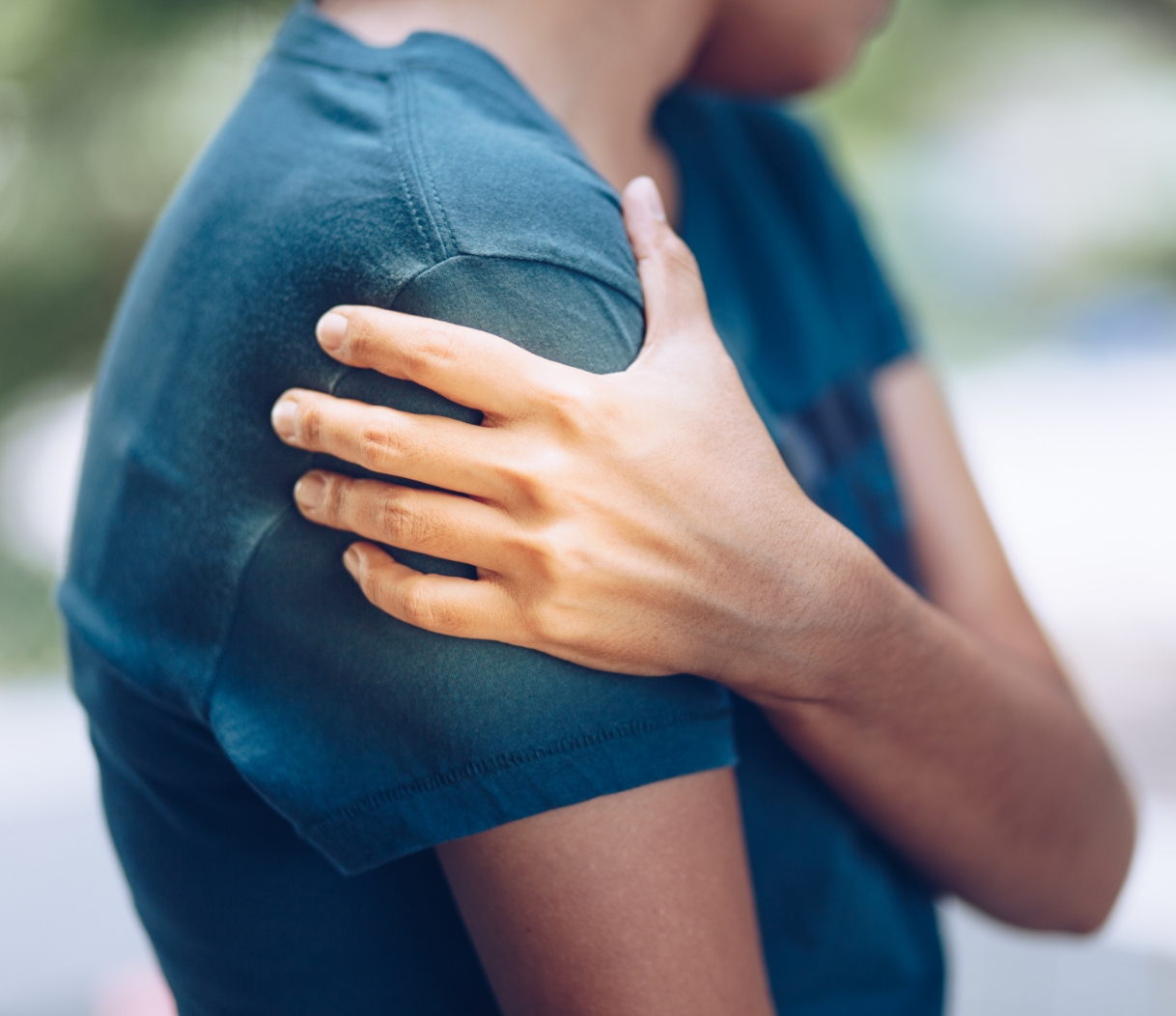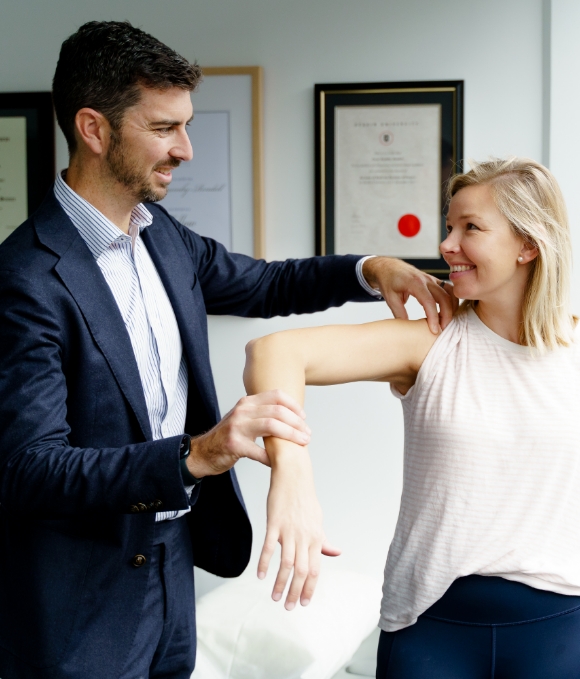Shoulder
Acromioclavicular (AC) Joint Dislocations
Also known as shoulder separation, is a dislocation of the clavicle from the acromion.
The most common cause of an AC dislocation is a fall directly onto the shoulder. An acromioclavicular (AC) joint dislocation occurs when the clavicle (collarbone) separates from the acromion of the scapula due to ligament damage around the AC joint.
The most common cause of an AC dislocation is a fall directly onto the shoulder, that's why this injury is mostly seen in people active in sports aside from those who experienced an accidental fall.

What is an AC joint dislocation or separation?
AC joint injuries frequently result from high-impact trauma, such as collisions in contact sports, mountain biking crashes, or motor vehicle accidents. The force drives the scapula downward while the clavicle shifts upward, overstretching or tearing the AC and coracoclavicular (CC) ligaments. Risk factors include cycling, skiing, snowboarding, rugby, and falls on an extended arm (FOOSH).
Symptoms by severity
Typical symptoms of an acromioclavicular separation or joint dislocation include:
- Pain and tenderness over the AC joint
- Swelling, bruising, and visible deformity—especially in higher grade injuries, where a “bump” may appear on the shoulder
- Reduced range of motion and weakness, particularly when lifting or rotating the arm
- Instability and discomfort during overhead activity, as well as difficulty sleeping on the affected side
Common risk factors include:
- Participation in contact sports such as football, hockey, soccer, basketball, or rugby.
- Accidents such as motor vehicle crashes.
- Gender - males are more likely than females to experience shoulder separation.
- Being prone to falls either because of age, occupation or participation in sports where falls are common (such as cycling or gymnastics).
- Previous shoulder separation - the more this injury happens, the easier and more likely it is for it to reoccur.
The shoulder is made up of a complex arrangement of bones, ligaments and other structures that work together to provide an extraordinary range of movement. Unfortunately, these structures are thin and can be easily damaged by direct injury to the area.
Classification: Rockwood Types I–VI
AC joint dislocations are classified using the Rockwood system, which evaluates ligament damage, displacement, and surrounding soft tissue involvement:
- Type I: AC ligament sprain only; no displacement.
- Type II: AC ligament torn; partial CC ligament damage; mild elevation (<25%).
- Type III: Both AC and CC ligaments torn; up to 100% clavicle elevation.
- Type IV: Clavicle displaced posteriorly into trapezius.
- Type V: Severe superior displacement (100–300%), with delto-trapezial fascia disruption.
- Type VI: Clavicle displaced inferior to acromion or coracoid—a very rare presentation.
Diagnosis of an AC joint separation
Diagnosis involves evaluating both the history of the patient's injury and the injury itself. A physical examination of the shoulder is performed to assess signs of fracture or dislocation. The AC joint is right under the skin, so this examination involves carefully feeling the bones and tissues around the AC joint, as well as comparing the arm's position to the uninjured one on the other side.
In severe cases, the deformity of the acromion will be a visible indicator of an AC joint dislocation. For more moderate cases, other tests may be required including:
- Testing the patient's range of motion to isolate specific areas of pain or weakness.
- X-rays to help determine whether the injury is a separation, a fracture or a total dislocation.

Treatment options
Non-surgical treatment
Treatment for shoulder separation depends on the severity of the injury. But as with all acute soft tissue injuries, first aid principles remain the same immediately after the injury occurs.
Icing the injury and supporting the arm with a sling can help reduce trauma in the first hours after the incident. Additionally, resting the arm in the acute state can help minimise pain and allow healing to begin. This is recommended for about 1-2 weeks after the injury.
Physiotherapy is then recommended to normalise joint range of motion, strengthen the shoulder, improve the shoulder blade and shoulder alignment, and help regain technique and function.
Surgical treatment
If the deformity is severe, surgery may be required to repair torn ligaments and trim back the end of the collarbone to reduce the joint.
Dr Brumby-Rendell performs these operations arthroscopically (keyhole surgery) wherever possible to reduce pain and promote faster recovery times. Most arthroscopic surgeries have a 95% patient satisfaction rate, with a complication rate of less than 1%.
Some patients elect for early surgery if their separation is severe. Candidates for early surgery may include:
- Gross displacement of the clavicle relative to the acromion
- Posteriorly unstable AC joint
- Labourers whose jobs require heavy overhead work
- Athletes whose shoulder movements are stressful and frequent
- Young active individuals
What does AC shoulder surgery involve?
The surgical procedure involves using small cuts in the shoulder to gain access to the injury site. Thin instruments specifically designed for arthroscopic surgery are inserted through the cuts, and a tiny camera gives Dr Brumby-Rendell vision of the shoulder from the inside.
Using this vision projected on a screen in the operating theatre to guide him, Dr Brumby-Rendell performs reconstruction of the affected ligaments, using a combination of small plates and a strong synthetic loop fixation to reduce AC space and re-position the coracoclavicular ligaments so they heal as close to the bone as possible.
Dr Brumby-Rendell may also shave protruding bone from the acromion if it was damaged at the time of injury or if it causes irritation or rubbing within the shoulder AC joint.
After the procedure, Dr Brumby-Rendell carefully removes the instruments and closes the small incisions.

Recovery after AC separation or dislocation surgery
Recovery times can vary depending on the severity of the injury and the type of surgery performed.
Generally, these guidelines apply:
- Keep your surgical dressing in place until reviewed by Dr Brumby-Rendell's practice nurse in the second post-operative week
- Stitches are usually removed by Dr Brumby-Rendell's practice nurse in the second post-operative week
- Elbow, wrist and hand exercises are encouraged to minimise stiffness
- A sling can be used but is not strictly necessary
- No lifting more than "a cup of tea" for 6 weeks
- 6-8 weeks of progressive strengthening and motion exercises begin after the removal of the sling
- Full recovery may take up to 4-6 months
Frequently Asked Questions
How Dr Oscar Brumby‑Rendell can help?
At the Adelaide Shoulder & Upper Limb Clinic, Dr Oscar Brumby‑Rendell offers tailored care for AC joint injuries:
-
Precise diagnosis using clinical examination and imaging
-
Conservative strategies including immobilization plans and evidence-based physical therapy guidance
-
Surgical expertise in arthroscopic and open reconstruction techniques when needed
-
Personalized post-treatment rehab programs focused on shoulder stability, strength, and safe return to activity
Dr Brumby‑Rendell’s subspecialty experience ensures patients receive expert decision-making aligned with their lifestyle demands and recovery goals.
Patients benefit from his focused knowledge in shoulder trauma and advanced surgical techniques. With multiple clinics across Adelaide and a multidisciplinary rehab approach, he prioritizes effective healing, optimal functionality, and minimal downtime for active individuals and athletes alike.

Ready to learn more?
Learn more about shoulder-related injuries with Dr Oscar Brumby-Rendell. In this video we'll be talking about Shoulder Impignement & Bursitis.
Read more about them below:
Once you have a referral…
Book your consultation here.
